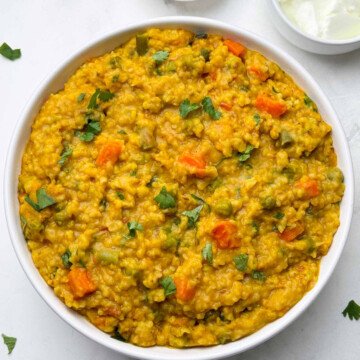
Dal Khichdi Recipe
Dal Khichdi is a comforting one-pot dish made with rice and lentils, often spiced with turmeric and cumin. It typically includes vegetables like peas and carrots, making it a nutritious and wholesome meal. Commonly enjoyed in Indian households, it's easy to digest and often served with yogurt or pickles, making it a favorite for both everyday meals and recovery foods.
Ingredients
Ingredients
- 1 Cup Rice
- ½ Cup Yellow mung lentils (moong dal)
- 1 tablespoon Ghee or oil
- 1 teaspoon Cumin seeds
- 1 teaspoon Ginger, finely chopped
- ½ teaspoon Black pepper
- ¼ teaspoon Asafoetida (hing)
- 1 teaspoon Turmeric powder
- 1 teaspoon Salt (adjust to taste)
- 4 Cup Water
- ½ Cup Chopped vegetables(optional; such as carrots, peas, or potatoes)
- Fresh coriander leaves for garnish
Instructions
Rinse and Soak
- To start, rinse the rice and mung lentils under cold water.
- Then, soak them together in water for about 10 minutes. This helps them cook faster and makes them easier to digest.
Prepare the Base
- Next, heat ghee or oil in a large pot over medium heat.
- After that, add cumin seeds and let them sizzle for about 30 seconds. This step adds a yummy flavor to the dish.
Saute Spices
- Now, add chopped ginger and cook it until it turns golden brown.
- Then, add black pepper, asafoetida, and turmeric powder, stirring for a minute. This is important because it brings out all the flavors.
Cook the Khichdi
- After that, add the rinsed rice and mung lentils to the pot.
- Pour in water and add chopped vegetables if you want. Stir everything well, bring it to a boil, and then reduce the heat to low.
- Cover the pot and let it simmer for 20-25 minutes. The khichdi is ready when everything is soft and flavorful.
Adjust Seasoning
- At this point, check how it tastes and looks. If needed, add more salt or water to get the texture you like. If you want it thicker, just cook it a little longer.
Garnish and Serve
- Finally, garnish the khichdi with fresh coriander leaves.
- Serve it hot and enjoy! You can also have it with yogurt or pickle for extra flavor.
Notes
Variations
-
- Add-Ins: I love making vegetable khichdi with peas, carrots, and pumpkin for more texture and flavor! You can also add zucchini for a nice crunch!
-
- Moong Dal vs. Masoor Dal: When I use moong dal, it turns out super smooth and creamy. But if I want more texture, I go for masoor dal—it has a heartier bite.
-
- Spicy Khichdi: For a kick, I add green chilies and garam masala—it reminds me of the spicy khichdi my dad makes!
-
- Healthier Version: I sometimes swap white rice for quinoa or millets to make it even healthier.
Tips and Trick for Perfect Dal Khichdi
1. Cooking Tips: To cook the perfect Dal Khichdi, it’s important to get the rice and dal to the right soft texture. First, make sure to use the right amount of water. If you use too little, it will be dry, and if you use too much, it will become mushy. In addition, cooking it on a low simmer helps prevent it from overcooking and losing its texture. 2. Adding Ghee: Moreover, adding ghee at the end of cooking enhances the flavor, giving it a rich and buttery taste. Not only does it improve the flavor, but it also provides various health benefits, such as boosting digestion. 3. Texture Control: In terms of texture, you can easily adjust it based on your preferences. For instance, if you prefer a porridge-like consistency, simply add more water. On the other hand, for a more pilaf-style version, reduce the liquid slightly. 4. Making it Vegan: If you're looking to make it vegan, simply swap the ghee for coconut oil or olive oil. These alternatives will provide a tasty, plant-based option!Nutrition
Nutrition Facts
Dal Khichdi Recipe
Amount per Serving
Calories
950
% Daily Value*
Fat
20
g
31
%
Saturated Fat
8
g
50
%
Polyunsaturated Fat
2
g
Monounsaturated Fat
10
g
Sodium
800
mg
35
%
Potassium
1300
mg
37
%
Carbohydrates
150
g
50
%
Fiber
18
g
75
%
Sugar
4
g
4
%
Protein
28
g
56
%
Vitamin A
900
IU
18
%
Vitamin B1
0.4
mg
27
%
Vitamin B2
0.3
mg
18
%
Vitamin B3
4
mg
20
%
Vitamin B5
0.5
mg
5
%
Vitamin B6
0.5
mg
25
%
Vitamin C
15
mg
18
%
Vitamin E
2
mg
13
%
Vitamin K
5
µg
5
%
Calcium
80
mg
8
%
Iron
4
mg
22
%
* Percent Daily Values are based on a 2000 calorie diet.
Tried this recipe?Let us know how it was!